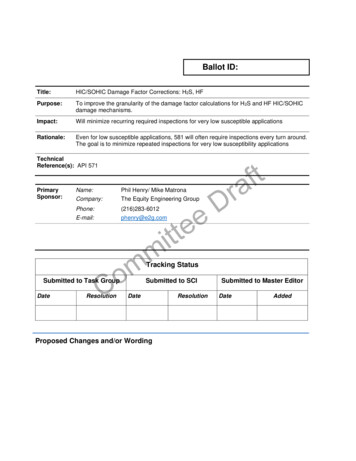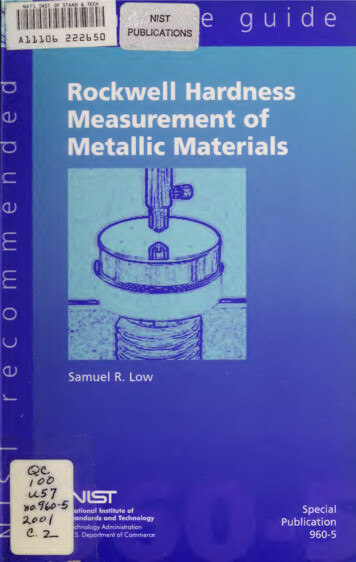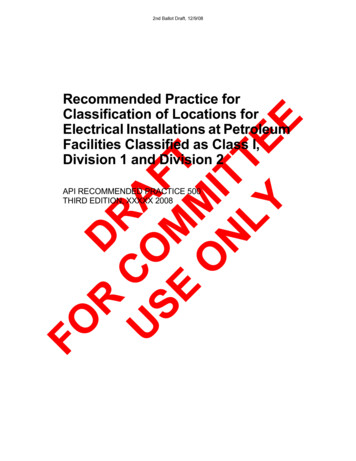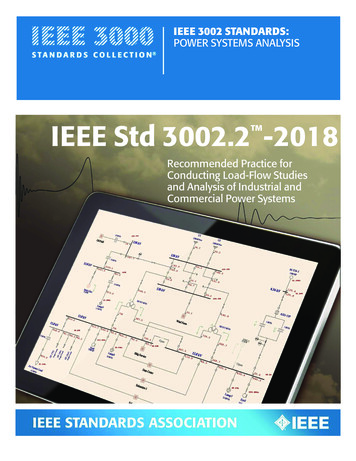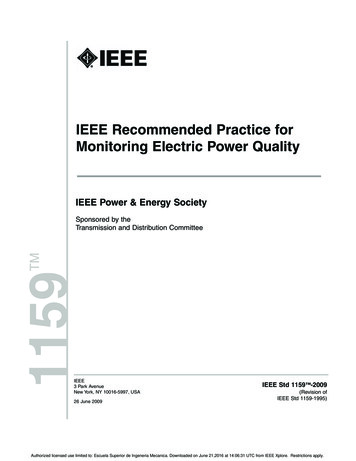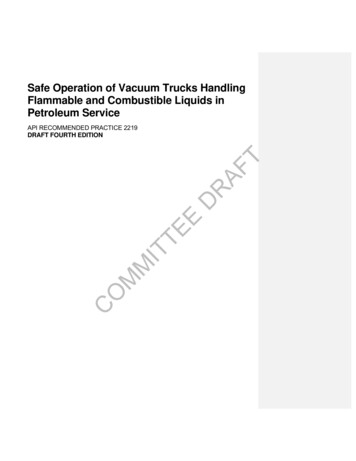
Transcription
Safe Operation of Vacuum Trucks HandlingFlammable and Combustible Liquids inPetroleum ServiceCOMMITTEEDRAFTAPI RECOMMENDED PRACTICE 2219DRAFT FOURTH EDITION
2API RECOMMENDED PRACTICE 2219FOREWORDThis fourth edition of Safe Operation of Vacuum Trucks in Petroleum Service provides information concerning the safeoperation of vacuum trucks engaged in all aspects of handling flammable and combustible liquids, associated wastewater, produced water, sour water, basic sediment and water (BS&W), caustics, spent acids, or other fluids stemmingfrom petroleum operations, products, powders and the hazard of dust explosions. This publication discusses the typesof vacuum pumps and cargo tanks associated with vacuum truck operations, the common hazards associated withthose vacuum truck operations and representative safe work practices and precautions to help prevent accidents andinjuries. Appendix G provides brief descriptions of a variety of incidents involving vacuum trucks, including offloadinginto open areas. These may be useful in reviewing specific operating procedures or developing materials for safetymeetings or pre-job briefings.AFTVacuum truck personnel working in petroleum facilities shall be trained in the safe operation of the vacuum equipment,familiar with the hazards of the products being handled and aware of relevant facility permit requirements, safetyprocedures and emergency response requirements. It is the responsibility of the vacuum truck owner and operator tocomply with (1) applicable federal, state and local regulations; (2) this recommended practice and (3) facility requirements regarding the safe operation of vacuum trucks; including, but not limited to, the following items:R* Construction, inspection, maintenance and certification of the vacuum tank.* Regulatory requirements for safe highway operation of the truck.D* Selection and safe operation of the vacuum truck, vacuum pump, hoses and accessories.TEE* Proper transportation, handling and disposal of hazardous materials.* Safe vacuum truck loading, unloading and transport operations within the facility.* Training and qualification of operators and other assigned vacuum truck personnel.COMMITAlthough the material contained in this document is intended to be consistent with regulatory requirements, API RP2219 is not a compliance document. Each user or operator must ensure compliance with all applicable laws andregulations. The United States Department of Transportation (DOT) Code of Federal Regulations, 49 CFR, specifiesthe minimum requirements for the design, construction, maintenance, testing and operation of vehicles used forhandling and transporting hazardous materials within the United States. Criteria for minimum training and qualifications of drivers and operators are also found in 49 CFR. The Department of Labor, Occupational Safety and HealthAdministration's (OSHA) requirements for safety, health and hazard awareness applicable to operators and otherpersonnel working with vacuum truck operations are found in the Code of Federal Regulations, 29 CFR 1910. U. S.Coast Guard regulations in 33 CFR 154 for bulk transfer of hazardous materials to and from vessels at marine facilitiescould include certain vacuum truck transfer operations.The procedures contained herein are intended to apply to vacuum trucks, skids and trailers used in flammable andcombustible liquid service. These requirements include, but are not limited to, 49 CFR parts 178.345 - 178.348 as wellas DOT 407 and DOT 412 (formerly designated MC307 and MC312) cargo tank trailers used in vacuum and transferoperations for handling and transporting flammable and combustible liquids and corrosive materials.Nothing contained in any API publication is to be construed as granting any right, by implication or otherwise, for themanufacture, sale, or use of any method, apparatus, or product covered by letters patent. Neither should anythingcontained in the publication be construed as insuring anyone against liability for infringement of letters patent.
SAFE OPERATION OF VACUUM TRUCKS IN PETROLEUM SERVICE3Safe Operation of Vacuum Trucks In Petroleum Service11.1GeneralINTRODUCTIONVacuum trucks are used in all segments of the petroleum industry with varied applications. Appropriate safe operatingpractices may vary because of different hazards associated with the materials to be moved and the facilities serviced.This recommended practice seeks to assist in the development and implementation of practical and safe operatingpractices that will help identify hazards and reduce risks.1.2SCOPEAFTThe scope of this recommended practice includes the use of vacuum/pressure trucks, skids, portable tanks andtrailers (herein referred to as vacuum trucks) to remove flammable and combustible liquids from tanks and equipmentand to clean up liquid hydrocarbon spills. The scope includes movement of liquid mixtures (such as “produced water”,BS&W or tank bottoms) that may contain sufficient hydrocarbon material to present comparable hazards.BASIC VACUUM OPERATIONSTEE1.3DRThese safe practices also apply to the operation of portable vacuum tanks, skids and trailers typically used in emergency flammable and combustible liquid spill cleanup activities. While not included in the specific scope of thisstandard, Appendix F presents information related to pneumatic (air moving) trucks and hoppers, typically used in thepetroleum industry for removal of dry materials such as catalysts, dusts, powders or, residue.The two basic types of vacuum truck operations are:1. Vacuum loading and off-loading operations that eliminate or minimize the introduction of air into the system by:ITa. Completely submerging the suction nozzle into the liquid during the transfer process and orMb. Directly connecting the transfer hose to the source or receiving tank, vessel or container, below the surface level ofthe liquid contained therein.M2. Vacuum truck operations that introduce air into the system during the transfer process, including:Oa. Air conveying operations (Appendix F) involving the incidental removal of solid materials when the suction hoseis either partially submerged or not submerged (or if submerged, when air is entrained or entrapped in the material)or the intentional removal of solids when used in a vacuum excavation system, orCb. Liquid transfer operations where the end of the hose is not directly connected to the source or receiving tank,container or vessel or the nozzle is not submerged into the liquid within the tank, container or vessel, and orc. Vacuum truck operations involving spill cleanup of liquids where air enters the transfer hose as liquids areskimmed off the surface (water or land).1.4CONCEPT OF HAZARD VS. RISKHazards are conditions or properties of materials with the inherent ability to cause harm. Risk involves the potential forexposure to hazards that will result in harm or damage. For example, a hot surface or material can cause thermal skinburns or a corrosive acid can cause chemical skin burns, but these injuries can occur only if there is contact exposureto skin. A person working at an elevated height has “stored energy” and a fall from a height can cause injury—but thereis no risk unless a person is working at heights and is thus exposed to the hazard. There is no risk when there is nopotential for exposure.
4API RECOMMENDED PRACTICE 2219Determining the level of risk for any activity involves understanding hazards and estimating the probability and severityof exposure that could lead to harm or damage. The preceding examples relate the consequences of hazard exposure, severity and probability to determine risks to people. The same principles can be applied to property risk. Forinstance, hydrocarbon vapors in a flammable mixture with air can ignite if exposed to a source of ignition resulting in afire which could damage property as well as cause injury.The U.S. Department of Transportation and the United Nations provide specific definitions and classifications for“Hazardous Materials”. These more general performance-based concepts are significant in order to understand thepotential risk associated with vacuum truck operations.1.5JOB HAZARD ANALYSISAFTThose in charge of vacuum truck operations can implement the principles of Hazard vs. Risk by conducting a jobhazard safety analysis (JHSA) to assess hazards and risks associated with specific tasks. This review, sometimesalso called a job safety analysis (JSA), helps identify hazards so that protective equipment, procedures and contingency plans can be put in place to mitigate risks associated with identified hazards.ReferencesTEE2DRPrior to engaging in jobsite vacuum truck operations, the relevant, written JHAs/JSAs should shall be reviewed by anentire crew including third party workers all relevant and responsible parties, to help everyone become familiar with thehazards, risks and exposure protection safeguards. Such JHAs/JSAs should be periodically reviewed so they remaincurrent and can help to prevent incidents. (See OSHA Publication 3071, Job Hazard Analysis, or otherJHA/JSA-related material from OSHA's web site.).The most recent editions of each of the following standards, codes, and publications are referenced in this recommended practice as useful sources of additional information. Further information may be available from the citedInternet World Wide Web sites or references included in the Appendix A Bibliography.RP 2003ITAPIProtection Against Ignitions Arising Out of Static, Lightning & Stray Currents.1 MACGIH O2ASMEMTLV’s and BEIs Based on Threshold Limit Values for Chemical Substances and Physical Agentsand Biological Exposure Indices.CASME Boiler And Pressure Vessel Code Section VIII: Pressure Vessels—Division 1ASME Boiler And Pressure Vessel Code Section XII: Rules for Construction and Continued Service of TransportTanks.NFPA31NFPA 30Flammable and Combustible Liquids Code.NFPA 77Recommended Practice on Static ElectricityAmerican Conference of Governmental Industrial Hygienists, 1330 Kemper Meadow Drive, Cincinnati, Ohio, 45240, www.acgih.org.American Society of Mechanical Engineers International, Three Park Avenue, New York, New York, 10016, www.asme.org, ASME International [Publications], 22 Law Drive, Box 2900, Fairfield, New Jersey, 07007-2900.3National Fire Protection Association, 1 Batterymarch Park, Quincy, Massachusetts, 02169, www.nfpa.org.2
SAFE OPERATION OF VACUUM TRUCKS IN PETROLEUM SERVICE5NFPA 326Safeguarding of Tanks and Containers for Entry, Cleaning or Repair.NFPA 650Pneumatic Conveying Systems for Handling Combustible Particulate Solids.NTTC4Hazardous Materials Transportation—The Tank Truck Driver’s Guide.NIOSH5NIOSH Pocket Guide to Chemical Hazards.Electrostatic Ignitions of Fires and Explosions ISBN 0-8169-9948-1, AIChE CCPSAFTPratt, Thomas H.OSHA6Employee Emergency Plans and Fire Prevention Plans1910.1000Subpart Z, Toxic and Hazardous Substances.1910.132Subpart I, Personal Protective Equipment.1910.147Control of Hazardous Energy (Lockout/Tagout).1910.157Fire Protection1910.1200Hazard Communication.DOTTEEMFederal Motor Carrier Safety Administration.MProtection of Environment.8OFederal Motor Carrier Safety Regulations (Parts 100-199—especially noting Parts 178.345 –178.348, 382, 383, 390-397, 407, and 412).C49 CFRITEPA740 CFRD1910.38R29 Code of Federal Regulations (CFR) Parts 1910.For specific requirements, carriers and shippers should consult the most current edition of 49 CFR Parts 100-185.Motor Carriers should also consult the Federal Motor Carrier Safety Regulations.3DefinitionsThe following definitions are applicable to this publication:4The National Tank Truck Carriers, Inc., 2200 Mill Road, Alexandria, Virginia, 22314, www.tanktruck.net.org.National Institute for Occupational Safety and Health, 4676 Columbia Parkway, Cincinnati, Ohio, 45226, www.cdc.gov/niosh.U.S. Department of Labor, Occupational Safety and Health Administration, 200 Constitution Ave. N.W., Washington, D.C., 20210,www.osha.gov.7U.S. Environmental Protection Agency, Ariel Rios Building, 1200 Pennsylvania Avenue, N.W., Washington, D.C., 20460, www.epa.gov.8U.S. Department of Transportation, 400 7th Street, S.W., Washington, D.C., 20590, www.dot.gov.56
6API RECOMMENDED PRACTICE 221953.1 atmospheric pressure: At sea level equals 14.7 psi (10 pascals) or 29.92 in Hg (760 mm Hg).3.2 bonding: Providing electrical connections between isolated conductive parts of a system to equalize theirelectrical potential (voltage). A bond resistance as high as 1 megohm (106 ohm) is adequate for static dissipation. Thetargeted goal for bonding should be 0 ohm. For stray current protection, lightning protection, and other electricalsystems, the bonding resistance needs to be significantly lower, no more than about 10 ohms.3.3 BS&W: An abbreviation for “Basic Sediment and Water,” measured as a volume percentage from a liquidsample of the production stream. It includes free water, sediment and emulsion. BS&W may entrain flammable orcombustible hydrocarbons or oily emulsions and then may release those hydrocarbons during service handling.AFT3.4 CHEMTREC: An acronym for “CHEMical TRansportation Emergency Center”, a system organized and coordinated by the American Chemistry Council to provide chemical-specific information to emergency respondersaround-the-clock.3.5 cyclone separators: Devices that separate oil and water or solid materials from air by cyclone action.R3.6 exposure limit: The maximum concentration limits for toxic substances to which workers may be safely exposed for a prescribed time without protection ( e.g., respiratory protection).TEEDexposure limits are usually expressed in parts per million (volume) or milligrams per cubic meter, averaged fora prescribed time, e.g., 15 minutes, 8 hours. They may also be expressed as ceiling limits, which should not beexceeded. Material Safety Data Sheets (SDSs) available from employers, manufacturers or suppliers of thematerial
API RP 2003 Protection Against Ignitions Arising Out of Static, Lightning & Stray Currents. ACGIH1 TLV’s and BEIs Based on Threshold Limit Values for Chemical Substances and Physical Agents and Biological Exposure Indices. ASME2 ASME Boiler And Pressure Vessel Code Section VIII: Pressure Vessels—Division 1

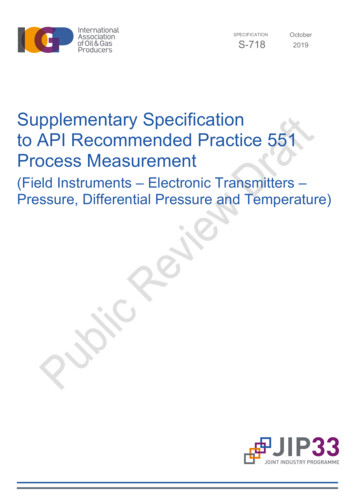
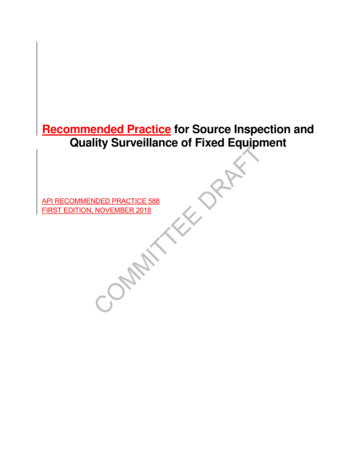
![API Ballot: [Ballot ID] – API 510 & API 570, Deferrals, Rev05](/img/5/api510andapi570deferralsrev5.jpg)

